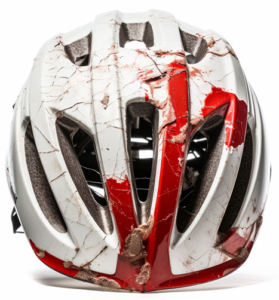Do Bike Helmets Expire?
How Long Do Bike Helmets Last?
Bike Helmet Lifespan
Introduction
When you hop on your bike for an exhilarating ride, your helmet is your trusty sidekick, ensuring your safety on the road. But have you ever wondered about the lifespan of your bike helmet or when it’s time to replace it?
In this helpful guide, we’ll answer those questions and more.
Included in this article are the topics of…
Table of Contents
The Importance of Bike Helmet Safety
How Long Do Bike Helmets Last?
Typical lifespan of a bike helmet
Variations based on usage and care
Understanding Bike Helmet Lifespan
Components of a bike helmet
Factors that affect helmet longevity
How Often to Replace Your Bike Helmet
Recommended replacement timeline
Signs your helmet might need replacement
When to Replace Your Bike Helmet
Clear indicators it’s time for a new helmet
Importance of not ignoring potential risks
Caring for Your Bike Helmet
Proper storage and maintenance
Tips for keeping your helmet in top condition
Safety Standards and Certifications
Understanding helmet safety certifications
Why investing in a quality helmet matters
Donating or Recycling Old Helmets
Responsible disposal of old helmets
Options for repurposing or donating
Conclusion
Recap of key points
The importance of prioritizing safety on the road
FAQs About Bike Helmet Expiration
Common questions and detailed answers for further clarification
The Importance of Bike Helmet Safety
Bike helmet safety is not just a recommendation; it’s an essential aspect of responsible cycling.
Your head is one of your body’s most vital parts, and a properly fitted and well-maintained helmet is your first line of defense against potentially life-altering head injuries.
In the event of a fall or collision, a helmet absorbs the force of impact, reducing the risk of head trauma, concussions, or more severe injuries.
It’s not just about obeying the law or following guidelines; it’s about safeguarding your well-being and preserving your ability to enjoy the thrill of cycling for years to come.
Remember, a helmet isn’t a fashion accessory; it’s a safety device that should be an integral part of every cyclist’s gear. Prioritizing bike helmet safety is a commitment to your health and the enjoyment of your cycling adventures.
How Long Do Bike Helmets Last?
While there isn’t an exact expiration date, bike helmets typically last around 3 to 5 years. However, this timeline can vary based on several key factors.
Variations Based on Usage and Care
The lifespan of your bike helmet can significantly vary based on how frequently you use it and the level of care it receives.
If you’re an avid cyclist who hits the road or trails daily, your helmet may experience more wear and tear compared to an occasional rider.
The more you use your helmet, the faster it may show signs of aging, even if there are no visible impacts.
Additionally, the way you care for your helmet plays a crucial role.
Proper maintenance, such as cleaning it with a mild soap and water solution and storing it in a cool, dry place away from direct sunlight, can help extend its life.
On the other hand, if your helmet is subjected to harsh conditions or stored carelessly, it might wear out more quickly.
In summary, the longevity of your bike helmet is closely tied to how often you use it and the care it receives.
Regular inspections and proper maintenance are key to ensuring it remains effective in providing the protection you need while cycling.
Understanding Bike Helmet Lifespan
Components of a Bike Helmet
Before we delve into the lifespan of bike helmets, let’s break down their components.
A standard bike helmet consists of two crucial elements: a hard outer shell and an inner foam layer.
These elements work together to protect your head during an accident or fall.
Factors That Affect Helmet Longevity
The lifespan of a bike helmet isn’t solely determined by the passage of time; it’s influenced by several key factors…
First and foremost is the frequency of use.
If you’re a dedicated cyclist who hits the road daily, your helmet may wear out sooner than someone who enjoys occasional leisurely rides.
Additionally, how you care for and store your helmet plays a significant role.
Proper storage in a cool, dry place away from direct sunlight can help extend its life.
Furthermore, the impact history of your helmet is crucial.
If it has been in a crash or even suffered a significant drop, the inner foam may have compressed, rendering it less effective.
Lastly, exposure to the elements, especially sunlight, can weaken the helmet’s materials over time.
Considering these factors will help you better understand the longevity of your bike helmet and when it might be time for a replacement.
How Often to Replace Your Bike Helmet?
Recommended Replacement Timeline
To ensure optimal safety, it’s generally recommended to replace your bike helmet every 3 to 5 years. However, this isn’t a strict rule; other factors come into play.
Signs Your Helmet Might Need Replacement…
When to Replace Your Bike Helmet?
Now, let’s explore the signs that indicate it’s time to bid farewell to your old helmet and invest in a new one.
Clear Indicators It’s Time for a New Helmet
Visible Damage
Cracks, dents, or significant damage to the outer shell are clear indicators that it’s time for a new helmet.
Loose Straps
If the straps have lost their elasticity and no longer secure the helmet properly, it’s time for a replacement.
Aging Foam
Over time, the foam inside the helmet can deteriorate. If it feels brittle or crumbly, it’s time for a new one.
Styrofoam Compression
If you’ve been in a crash or even dropped your helmet hard, the inner foam can compress, reducing its protective capabilities.
Fading Colors
Sun exposure can weaken a helmet’s materials. If the colors have faded significantly, it’s a sign that it might be time for a new one.
Caring for Your Bike Helmet
Proper Storage and Maintenance
To extend your helmet’s lifespan, it’s crucial to follow proper storage and maintenance practices.
Tips for Keeping Your Helmet in Top Condition
Store it in a cool, dry place away from direct sunlight.
Clean it gently with a mild soap and water solution.
Handle it with care; don’t toss it around.
Safety Standards and Certifications
Understanding Helmet Safety Certifications
Many countries have safety standards for bike helmets. Look for certifications like CPSC, ASTM, or Snell to ensure your helmet meets safety requirements.
Why Investing in a Quality Helmet Matters
Quality helmets often come with advanced safety features and materials that provide better protection. Your safety on the road is worth the investment.
Donating or Recycling Old Helmets
Responsible Disposal of Old Helmets
Instead of tossing your old helmet in the trash, consider recycling programs or repurposing it for non-safety activities like gardening or crafts.
Options for Repurposing or Donating
While it’s kind to want to donate old helmets, donating a helmet with an unknown history may not guarantee safety for the recipient.
Conclusion
Recap of Key Points
In conclusion, bike helmets don’t have an official expiration date, but their effectiveness can diminish over time.
Regularly inspect your helmet for signs of wear and damage, and when in doubt, replace it for your safety.
The Importance of Prioritizing Safety on the Road
Your safety on the road is paramount, and a well-maintained helmet is your first line of defense. Stay safe and enjoy your rides!
FAQs About Bike Helmet Expiration
Common Questions and Detailed Answers
Now, let’s address some common questions regarding bike helmet expiration and replacement to provide further clarity on this important topic.
Q1: How long do bike helmets typically last?
A1: Bike helmets typically last around 3 to 5 years, depending on factors like usage, care, and storage. Regularly inspecting your helmet for signs of wear and damage is crucial.
Q2: Is it safe to use an older helmet that still looks okay?
A2: While an older helmet may look fine externally, it may have internal damage or compromised materials. It’s best to follow the recommended replacement guidelines for your safety.
Q3: Can I extend the lifespan of my helmet with proper care?
A3: Yes, you can prolong your helmet’s life with proper care. Store it in a cool, dry place, clean it gently with a mild soap and water solution, and handle it with care.
Q4: What should I do if my helmet has been in a crash or suffered an impact?
A4: If your helmet has been in a crash or sustained a significant impact, it’s crucial to replace it. Even if there’s no visible damage, the internal foam may be compromised.
Q5: Are there specific guidelines for child bike helmets?
A5: Child bike helmets should be replaced similarly to adult helmets, but consider the growth of the child. If a child’s head has grown significantly since the last helmet purchase, it’s time for a larger size.
Q6: Can I donate my old helmet if it’s still in good condition?
A6: While it’s kind to want to donate old helmets, it’s generally recommended to dispose of them. Donating a helmet with an unknown history may be unsafe for the recipient.
Q7: Can I customize or decorate my bike helmet?
A7: Yes, you can personalize your helmet with stickers and accessories designed for helmets. However, avoid using paint or adhesives that could damage the helmet’s materials.
Q8: Are there any regulations or standards for bike helmets?
A8: Yes, many countries have safety standards for bike helmets. Look for certifications like CPSC, ASTM, or Snell to ensure your helmet meets safety requirements.
Q9: What should I do with my old helmet when I replace it?
A9: Instead of tossing your old helmet in the trash, consider recycling programs or repurposing it for non-safety activities like gardening or crafts.
Q10: Is it worth investing in an expensive helmet?
A10: Yes, investing in a quality helmet is worth it for your safety. High-quality helmets often have advanced safety features and materials that provide better protection.


 bicycleandbikes.com
bicycleandbikes.com